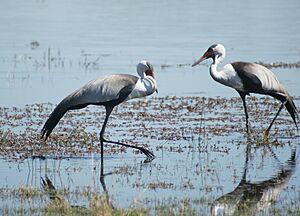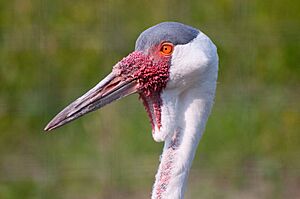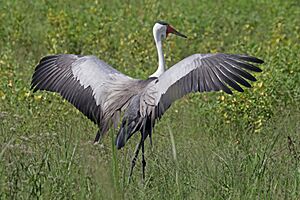Wattled crane facts for kids
Quick facts for kids Wattled crane |
|
|---|---|
 |
|
| Conservation status | |
| Scientific classification | |
| Genus: |
Grus
|
| Species: |
carunculata
|
| Synonyms | |
|
|
The wattled crane (Grus carunculata) is a very large bird. It is a type of crane that lives in Africa. You can find it in wet areas like marshes and grassy plains. These birds live in eastern and southern Africa, from Ethiopia all the way to South Africa. They are a threatened species, which means their numbers are getting low.
Contents
What is a Wattled Crane?
The wattled crane is the biggest crane in Africa. It is also the second tallest crane in the world. Only the sarus crane is taller. It can stand as tall as a person, from about 150 to 175 centimeters (5 to 5.7 feet) high.
This crane is also one of the heaviest flying birds in Africa. Its wings can spread very wide, from 230 to 260 centimeters (7.5 to 8.5 feet). Adult females usually weigh between 6.4 and 8.28 kilograms (14 to 18 pounds). Males are a bit heavier, weighing 7.5 to 9 kilograms (16.5 to 20 pounds).
How to Spot a Wattled Crane

Wattled cranes have a beautiful look. Their backs and wings are a gray color, like ash. The top of their head is dark gray, but the rest of their head is white.
They have special fleshy growths under their throat called wattles. These wattles are mostly covered in white feathers. The skin around their eyes and at the base of their beak is red and bumpy. Their chest, flight feathers, and tail feathers are black.
Wattled cranes have long beaks and black legs and toes. It's hard to tell males and females apart, but males are usually a little bigger. Young cranes look different. They have brownish feathers and don't have the red skin on their face or the big wattles yet.
Where Do Wattled Cranes Live?
Wattled cranes live in eleven countries in eastern and southern Africa. More than half of all wattled cranes live in Zambia. The largest group of them can be found in the Okavango Delta in Botswana.

In 2011, wattled cranes were seen in Uganda for the first time. This was in the Kibimba Rice region. This sighting added to the list of bird species found in Uganda. In 2018, a new group of these cranes was found in Angola.
What Do Wattled Cranes Eat?
Wattled cranes mostly live in wet areas that are hard to reach. They need shallow marshy places with lots of sedge plants. Like all cranes, they eat many different things.
Their main food comes from water plants. They dig up and eat the roots and stems of plants like sedges and water lilies. They are one of the cranes that eat the most plants. They also eat water insects. Sometimes, they will eat snails, amphibians, and even small snakes if they find them.
About 90% of the time, they look for food in shallow water. They dig into the muddy ground with their beaks. Sometimes, they will eat grain and grass seeds, but not as often as other African cranes.
Wattled Crane Behavior and Life Cycle
Wattled cranes move around depending on the water levels in their habitat. If there are floods, many cranes might gather in one area. These movements are more about finding good food spots than following a set migration path. However, some cranes in Mozambique do move from high to low areas.
Outside of breeding season, wattled cranes often gather in groups. These groups can have 10 or more birds, and sometimes even up to 89! Other types of cranes sometimes interact with them, but it's not common. Wattled cranes often share their habitat with lechwe (a type of antelope) and spur-winged goose.
Reproduction and Raising Young
Wattled cranes start their breeding season around April. Their nests are usually simple, flattened areas of grass near the edge of a marsh. They might use an old goose nest or build their own.
They lay eggs about three weeks after building the nest. Wattled cranes lay the fewest eggs of any crane species, usually about 1.6 eggs on average. Even if they lay two eggs, usually only one chick survives.
Both parents help to incubate the eggs, which takes about 33 to 36 days. This is the longest incubation period for any crane. Once the chicks hatch, both parents feed them. When there is danger, the parents push their young into tall grasses to hide.
The chicks learn to fly when they are 100 to 150 days old. This is also the longest time for any crane chick to fledge. The young cranes stay with their parents for up to a year. Then, they might join groups of other young cranes.
Why Are Wattled Cranes in Danger?
The biggest danger to wattled cranes is the loss and damage of their wetland homes. They are very sensitive to changes in their habitat. Big projects like hydroelectric dams and other water developments change the floodplains where they live. This also affects their main food source.
Other threats include people and livestock disturbing them. They can also get hurt by flying into power lines. Sometimes, people illegally collect their eggs, chicks, or even adult birds for food. Spraying for tsetse flies can also harm them.
The wattled crane is listed as "vulnerable" by the IUCN Red List. This means they need our help to protect them and their homes.



